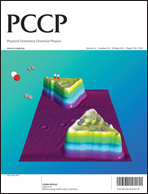We report results of a theoretical study, based on density functional theory (DFT), on the structural, electronic, optical, and chiroptical properties of small thiolated gold clusters, [Aun(SR)m (n = 12–15, 16–20; m = 9–12, 12–16)]. Some of these clusters correspond to those recently synthesized with the surfactant-free method. To study the cluster physical properties, we consider two cluster families with Au6 and Au8 cores, respectively, covered with dimer [Au2(SR)3] and trimer [Au3(SR)4] (CH3 being the R group) motifs or their combinations. Our DFT calculations show, by comparing the relaxed structures of the [Au6[Au2(SR)3]3]+, [Au6[Au2(SR)3]2[Au3(SR)4]]+, [Au6[Au2(SR)3][Au3(SR)4]2]+, and [Au6[Au3(SR)4]3]+ cationic clusters, that there is an increasing distortion in the Au6 core as each dimer is replaced by a longer trimer motif. For the clusters in the second family, Au8[Au3(SR)4]4, Au8[Au2(SR)3][Au3(SR)4]3, Au8[Au2(SR)3]2[Au3(SR)4]2, Au8[Au2(SR)3]3[Au3(SR)4], and Au8[Au2(SR)3]4, a smaller distortion of the Au8 core is observed as dimer motifs are substituted by trimer ones. An interesting trend emerging from the present calculations shows that as the number of trimer motifs increases in the protecting layer of both Au6 and Au8 cores, the average of the interatomic Au(core)–S distances reduces. This shrinkage in the Au(core)–S distances is correlated with an increase of the cluster HOMO–LUMO (H–L) gap. From these results, it is predicted that a larger number of trimer motifs in the cluster protecting layer would induce larger H–L gaps. By analyzing the electronic transitions that characterize the optical absorption and circular dichroism spectra of the clusters under study, it is observed that the molecular orbitals involved are composed of comparable proportions of orbitals corresponding to atoms forming the cluster core and the protecting dimer and trimer motifs.
![Graphical abstract: Structural, electronic, optical, and chiroptical properties of small thiolated gold clusters: the case of Au6 and Au8 cores protected with dimer [Au2(SR)3] and trimer [Au3(SR)4)] motifs](/en/Image/Get?imageInfo.ImageType=GA&imageInfo.ImageIdentifier.ManuscriptID=C2CP40643H&imageInfo.ImageIdentifier.Year=2012)

 Please wait while we load your content...
Please wait while we load your content...